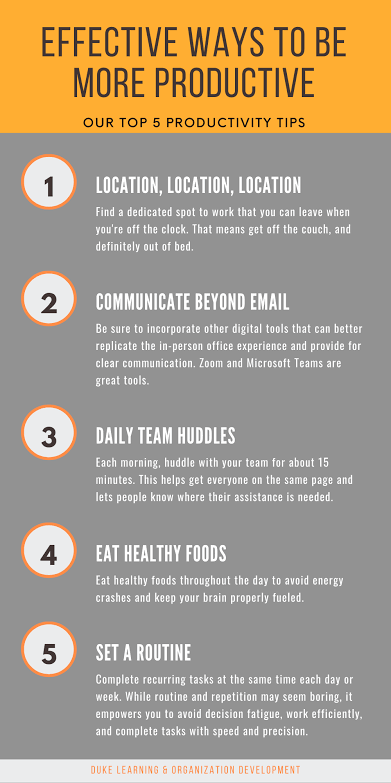In today’s fast-paced business environment, productivity is key to career growth and success. Here are ten practical tips to help you become a more productive employee:
- Set Clear Goals
Define your daily, weekly, and monthly goals. Break larger projects into smaller, manageable tasks to maintain focus and motivation. - Prioritize Tasks
Use the Eisenhower Matrix to prioritize tasks based on urgency and importance. Tackle high-priority tasks first to ensure critical work is completed on time. - Manage Time Effectively
Utilize time management techniques such as the Pomodoro Technique or time blocking. Allocate specific time slots for different tasks to avoid multitasking and stay focused. - Minimize Distractions
Identify common distractions in your workspace and take steps to minimize them. This could include using noise-canceling headphones, setting boundaries with colleagues, or using apps that block distracting websites. - Use Technology Wisely
Leverage productivity tools and apps to streamline your work processes. Tools like Trello, Asana, or Microsoft Teams can help manage projects and communicate efficiently with your team. - Take Regular Breaks
Avoid burnout by taking short breaks throughout the day. Use this time to stretch, walk, or practice mindfulness, which can boost your overall productivity and well-being. - Enhance Your Skills
Continuously seek opportunities for professional development. Taking courses to enhance your skills can make you more efficient and valuable to your organization. - Stay Organized
Keep your workspace and digital files organized. A clutter-free environment can help reduce stress and increase efficiency. - Communicate Effectively
Develop strong communication skills to collaborate better with colleagues. Clear and concise communication can prevent misunderstandings and save time. - Seek Feedback
Regularly ask for feedback from your supervisors and peers. Constructive feedback can help you identify areas for improvement and develop strategies to enhance your performance.
Recommended Courses for Enhancing Productivity
To view the table correctly on both mobile and desktop, it will adjust its layout according to the device’s screen size.
| Course Title | Summary | Link |
|---|---|---|
| Excel Skills for Business: Advanced | Learn advanced Excel skills including data cleaning, financial functions, and building professional dashboards. | Enroll Here |
| Data Visualization with Advanced Excel | Master advanced Excel functions and create dynamic dashboards to visualize and analyze data effectively. | Enroll Here |
| Business Analytics with Excel: Elementary to Advanced | Learn analytical frameworks and modeling techniques using Excel for decision-making in business contexts. | Enroll Here |
| Introduction to Data Analysis Using Excel | Gain a working knowledge of Excel for data analysis, from basic functions to advanced graphing and charting techniques. | Enroll Here |
| Data Analysis and Visualization Foundations Specialization | Understand core principles of data analysis and visualization using Excel, and build interactive dashboards. | Enroll Here |
Case Study: The Transformation of John Doe
John Doe, a project manager at XYZ Corporation, struggled with meeting deadlines and managing his team’s workload effectively. Realizing the need for change, he adopted the following strategies:
- Goal Setting and Prioritization
John started by setting clear goals for his projects and used the Eisenhower Matrix to prioritize his tasks. This helped him focus on urgent and important tasks first. - Time Management Techniques
He implemented the Pomodoro Technique, which improved his focus and productivity by breaking his work into intervals with short breaks in between. - Skill Enhancement
John enrolled in the “Business Analytics with Excel: Elementary to Advanced” course. This course taught him advanced modeling techniques and how to use data for decision-making, significantly improving his analytical skills. - Organizational Tools
John began using Trello to organize his tasks and projects. This visual approach to task management helped him keep track of deadlines and collaborate more effectively with his team.
By incorporating these strategies, John saw a marked improvement in his productivity. His team also benefited from his enhanced skills and better organizational practices, leading to more successful project outcomes.
Incorporating these tips and continuously seeking to improve can make you a more productive and efficient employee, setting you up for success in your career.


